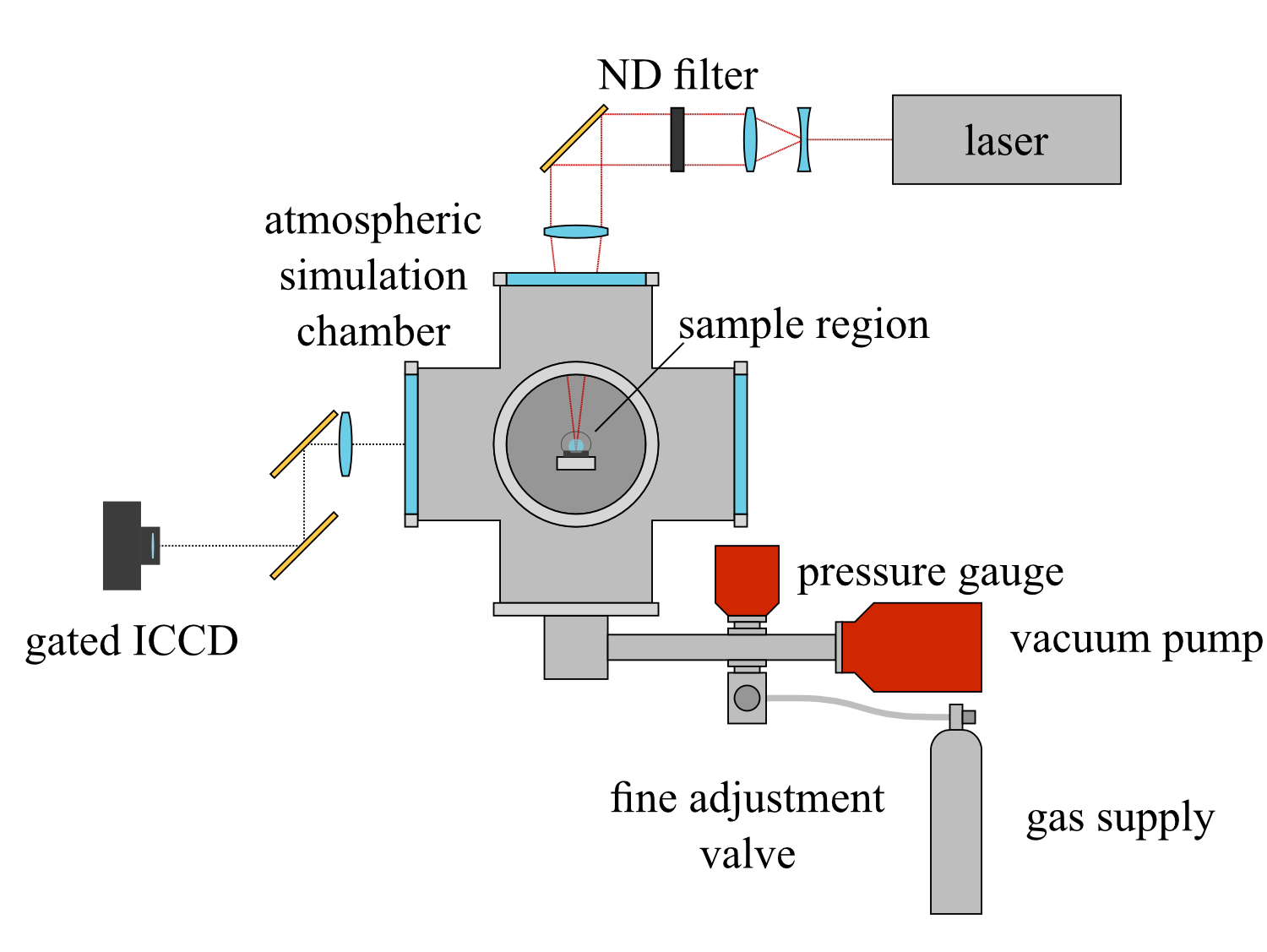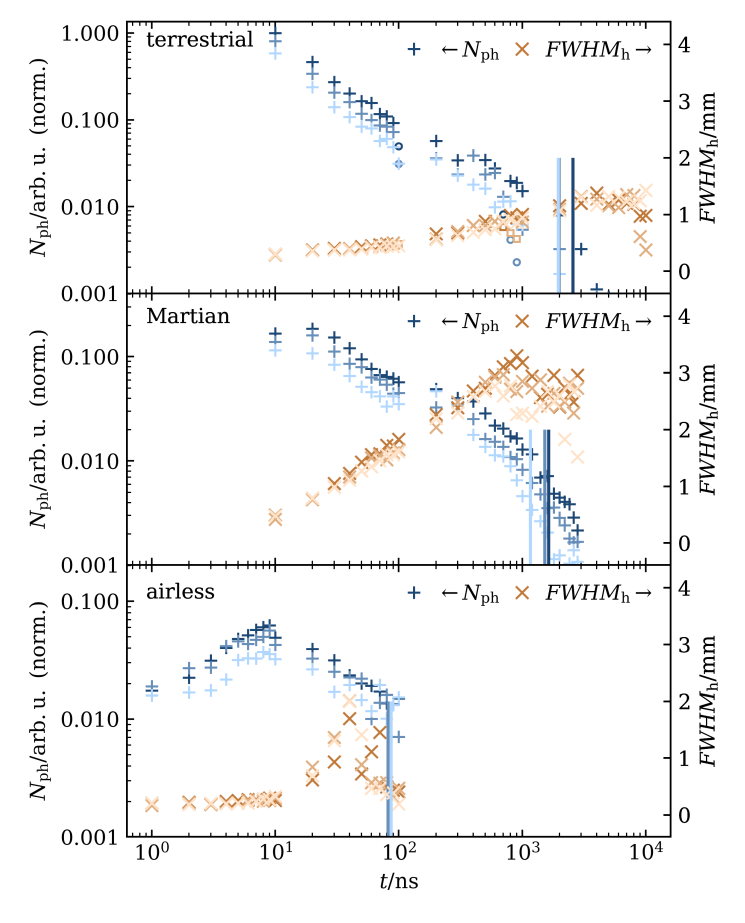Evolution of Laser-Induced Plasmas for In-Situ Analysis on Planetary Bodies
- 1German Aerospace Center (DLR), Institute of Optical Sensor Systems, Germany (fabian.seel@dlr.de)
- 2Humboldt Universität zu Berlin, Institute of Physics, Germany
Introduction: When the MSL rover Curiosity landed on Mars in 2012, it successfully demonstrated the use of Laser-Induced Breakdown Spectroscopy (LIBS) for in-situ geochemical investigations of planetary bodies for the first time [1]. Since then, the importance of LIBS for Solar System exploration has only grown, with several subsequent missions employing LIBS systems as part of their sensor
suite [2, 3]. LIBS measurements are performed by focusing a pulsed laser beam on the surface of a sample to generate a local plasma. The emission of this plasma is then analyzed to investigate the sample composition. Since the lifetime, size and emission of the laser-induced plasma depend strongly on experimental parameters [4, 5], LIBS instruments for in-situ analysis of planetary bodies have to be designed for specific environments to generate high-quality data. Important parameters include the ambient atmosphere, the laser irradiance and the sample lithology
Here, we present measurements of the plasma emission at different atmospheric conditions and laser irradiances for four samples with different lithologies to aid in the development of new LIBS instruments for in-situ geochemical research of planetary bodies.
Experimental Setup: To investigate the lifetime, size and emission of laser-induced plasmas, we use a plasma imaging system that employs a gated ICCD sensor to achieve a temporal resolution of down to 2 ns. The ICCD is most sensitive between about 300 nm and 900 nm. The plasma is generated by a 1064 nm Nd:YAG laser with a pulse duration of 8.1 ns and a spot diameter of about 40 µm.

Figure 1: Overview of the experimental setup.
Different atmospheric conditions can be simulated using a vacuum chamber in which the plasma is ignited, see Fig. 1. In this study, we focus on atmospheric conditions on Earth, Mars and airless planetary bodies such as the Moon.
Methodology: For all investigated samples, measurements were performed at terrestrial, Martian and airless conditions. The laser pulse energy was varied between 11.86 mJ, 8.75 mJ and 6.56 mJ, which corresponds to average irradiances of about 1300 MW/mm², 990 MW/mm² and 750 MW/mm². Four samples with different lithologies were investigated: LMS1 (pressed pellet), LHS1 (pressed pellet), soapstone (talc) and basalt (cut rock). For this abstract, we limit the discussion to data from the basalt sample.
Each plasma image was recorded from a single laser shot with ICCD gate times between 2 ns and 200 ns. All images were pre-processed by subtracting a dark image, applying a uniform filter to reduce the noise level and removing residual constant offsets. The total plasma emission was calculated as the sum over each image. To account for the different ICCD gate times, the total emission of each image was normalized with the gate time. The lifetime of the plasma was computed as the time that covers 90 % of the total detected plasma emission. The full width at half maximum sizes of the plasmas were calculated as the largest horizontal distance between points that show half of the maximum plasma emission of the image.
Results: Fig. 2 shows the expansion of the plasma plume from the basalt sample at the three investigated
atmospheric conditions for a laser energy of 8.75 mJ. All plasma images are normalized to their respective maximum. At 100 ns after plasma ignition, two plasma plumes are visible for the measurement performed at terrestrial conditions. This secondary breakdown is likely initiated on residual ejecta from the ablation process.

Figure 2:Time series of plasma images at the three investigated atmospheric conditions. Each plasma image is normalized to its respective maximum signal. Note the different time scales.
Overall, a change in the extent of the plasma and its dynamics is visible between different atmospheric conditions. The plasma’s lifetime is longest at terrestrial atmospheric conditions and shortest at airless conditions. At terrestrial conditions, the plasma is most confined. It is larger at Martian atmospheric conditions and at airless conditions, the plasma extends freely into the vacuum, which leads to a small and bright plasma core close to the sample surface.

Figure 3: Comparison of the development of the total emitted plasma radiation, the plasma’s horizontal and the plasma lifetime.. Note the different scales of the y-axes.
In Fig. 3, the total emission of the plasma is compared for the three atmospheric conditions and laser energies. Fainter colors represent lower laser energy. The data is normalized to the strongest emission at terrestrial conditions. The vertical lines represent the computed plasma lifetime. On the secondary y-axis, the is plotted. At terrestrial atmospheric conditions, the plasma is brightest at 10 ns after plasma ignition. The plasma reaches its maximum horizontal extend of about 1.3 mm around 3 µs after ignition. 90 % of the emission are contained within the first 2.5 µs. For Martian conditions, the peak emission occurs after about 20 ns and is about 20 % of the peak emission at terrestrial conditions. The plasma lifetime is reduced to about 1.5 µs and its maximum extend of about 3 mm is reached around 500 ns after ignition. Finally, for airless conditions the peak plasma emission is reduced to about 7% of the peak emission at terrestrial conditions with a lifetime of about 80 ns. The plasma reaches its maximum extent of about 2 mm after around 40 ns.
Conclusion: The presented data show the different behaviors of plasmas ignited at different atmospheric conditions. The maximum extent varies between about 1.3 mm for terrestrial conditions, 3 mm for Martian conditions and 2 mm for airless conditions. The plasma is brightest at Terrestrial atmospheric conditions. At Martian and airless conditions, the plasma’s peak emission is about 20% and 7% of that at terrestrial conditions, respectively. Part of this work was first presented at the 55th LPSC conference [6].
References: [1] Maurice, S. et al. (2016) J. Anal. At. Spectrom., 31(4), 863-889. [2] Maurice, S. et al. (2021) Space Sci. Rev., 217, 1-108. [3] Wan, X. (2021) At. Spectrosc., 42(6), 294-298. [4] Singh, J. P. and Thakur, S. N. (Eds.). (2020). Laser-induced breakdown spectroscopy. Elsevier. [5] Lasue, J. et al. (2012) J. Geophys. Res. Planets, 117, (E1). [6] Seel, F. et al. (2024) 55th LPSC, 1418.
How to cite: Seel, F., Schröder, S., Clavé, E., Dietz, E., Frohmann, S., Hansen, P. B., Rammelkamp, K., and Hübers, H.-W.: Evolution of Laser-Induced Plasmas for In-Situ Analysis on Planetary Bodies, Europlanet Science Congress 2024, Berlin, Germany, 8–13 Sep 2024, EPSC2024-232, https://doi.org/10.5194/epsc2024-232, 2024.